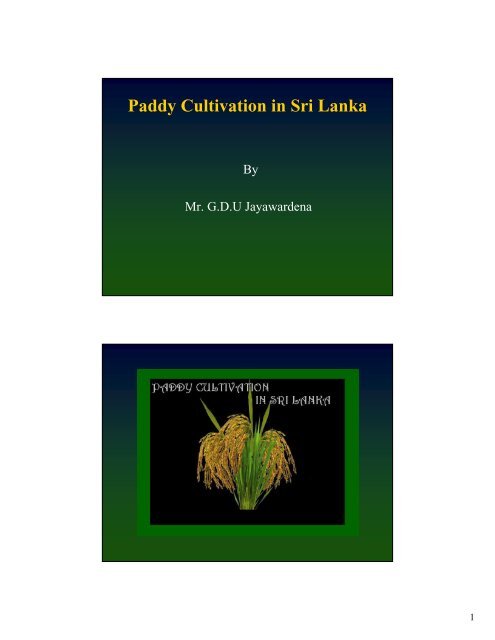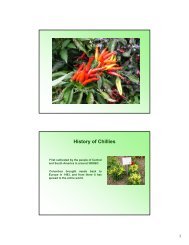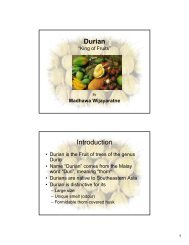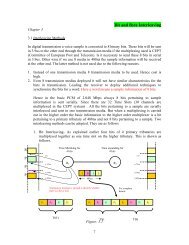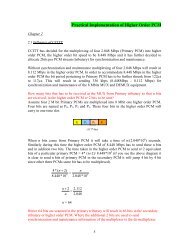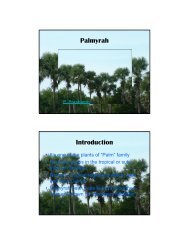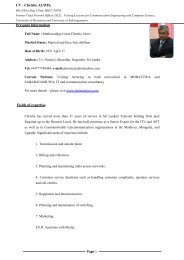Paddy Cultivation in Sri Lanka - Christiealwis.com
Paddy Cultivation in Sri Lanka - Christiealwis.com
Paddy Cultivation in Sri Lanka - Christiealwis.com
You also want an ePaper? Increase the reach of your titles
YUMPU automatically turns print PDFs into web optimized ePapers that Google loves.
<strong>Paddy</strong> <strong>Cultivation</strong> <strong>in</strong> <strong>Sri</strong> <strong>Lanka</strong><br />
By<br />
Mr. G.D.U Jayawardena<br />
1
Orig<strong>in</strong> of rice plant<br />
Evidence says <strong>in</strong> Ch<strong>in</strong>a or <strong>in</strong> India<br />
Species<br />
• 22 species are documented <strong>in</strong> the world<br />
- 20 wild species and 2 cultivated species<br />
• 2 cultivated species are<br />
» Orysa sativa (L.)<br />
Orysa glaberima (stedu)<br />
2
Available species <strong>in</strong> <strong>Sri</strong> <strong>Lanka</strong><br />
• 5 wild rices<br />
- O. nivara<br />
- O. ruffiphogon<br />
- O. risomatics<br />
- O. ech<strong>in</strong>gari<br />
- Cultivated species<br />
• O. sativa<br />
Group<br />
<strong>in</strong>dica<br />
Distribution of rice <strong>in</strong> <strong>Sri</strong> <strong>Lanka</strong><br />
3
Rice Extent...<br />
• <strong>Sri</strong> <strong>Lanka</strong> - 730,000 ha<br />
• Dry & Intermediate -<br />
610,000 ha<br />
• Wet Zone - 120,000 ha<br />
Agro Ecology<br />
4
District<br />
Kalutara<br />
Colombo<br />
Galle<br />
Gampaha<br />
Rathnapura<br />
K’galle<br />
Matara<br />
Districts<br />
Agro ecology<br />
WL1a, WL1b, WL2a<br />
WL1a, WL1b, WL2a, WL3<br />
WL1a, WL2a<br />
WL1a, WL1b, WL2b, WL3<br />
WL1a, WL2a<br />
WL1a,WL2b,<br />
WL1a, WL2a<br />
Av. Yield<br />
Bu/Ac<br />
56<br />
63<br />
72<br />
66<br />
59<br />
66<br />
73<br />
Until 1950 used<br />
Traditional methods<br />
5
Traditional methods<br />
• 1. Traditional rice varieties<br />
• 2. Conventional land preparation<br />
• 3. Organic fertilizer<br />
• 4. “Kem” methods for pest and Disease<br />
control<br />
• 5. Traditional harvest<strong>in</strong>g , process<strong>in</strong>g and<br />
stor<strong>in</strong>g methods<br />
6
Land preparation us<strong>in</strong>g mamoty<br />
Rural Agricultural Community Affair<br />
7
Traditional Rice Varieties<br />
•600 varieties were reported<br />
8
Gonabaru<br />
9
Kahatawee<br />
Sudu heenati<br />
10
Herath Banda<br />
Sulai-Traditional Rice variety<br />
11
Due to scarcity of lands and<br />
<strong>in</strong>crease of the population<br />
Agricultural Department take<br />
action to Develop the technology<br />
to <strong>in</strong>crease the rice production<br />
Varietal development<br />
• Breed<strong>in</strong>g objectives:<br />
- Increase yield potential<br />
- Incorporation of pest and disease resistance<br />
- Semi dwarf plant type<br />
- Response to fertilizer<br />
- Better gra<strong>in</strong> quality<br />
12
Breed<strong>in</strong>g Commence 1950<br />
First bred variety named as H4<br />
H- Hybridized<br />
There are four Breed<strong>in</strong>g Stations<br />
Station<br />
Batalagoda<br />
Bombuwala<br />
Labuduwa<br />
Ambalantota<br />
Abbreviation<br />
Bg<br />
Bw<br />
Ld<br />
At<br />
13
Rice Research &<br />
Development Institute<br />
Rice researchers centers<br />
Paranthan (RRS)<br />
Polonnaruwa (ARU)<br />
Ampara (RRS)<br />
RRDI (HQ) -Batalagoda<br />
Bombuwela (RARDC)<br />
Bentota (RRS)<br />
Labuduwa<br />
(RRS)<br />
Ambalantota (RRS)<br />
14
Institution Mandate<br />
Batalagoda (Varietal development &<br />
technology generation)<br />
• Dry & Int. Zones<br />
• High potential areas<br />
Bombuwela (Varietal development &<br />
technology generation)<br />
• Wet zone<br />
• Problem soils<br />
• Red rice<br />
Labuduwa (Varietal development Bentota&<br />
technology test<strong>in</strong>g)<br />
• LCWZ M<strong>in</strong>eral soils<br />
Ambalantota (Varietal development &<br />
technology generation)<br />
• Sal<strong>in</strong>ity<br />
• Red rice<br />
Bentota<br />
Ampara<br />
(Technology test<strong>in</strong>g)<br />
• Coastal sal<strong>in</strong>ity<br />
• Floods and submergence<br />
Polonnaruwa (Technology test<strong>in</strong>g)<br />
• High potential areas<br />
Ampara (Technology test<strong>in</strong>g)<br />
• High potential areas<br />
4 ½ Months<br />
Bg 379-2<br />
Bg 11-11<br />
Bg 450<br />
Bw 451<br />
Bw 452<br />
Bw 453<br />
4 Months<br />
Bw 400<br />
Bg 401<br />
At 402<br />
Bg 403<br />
Bg 405<br />
Bg 407(H)<br />
3 ½ Months<br />
Bg 350<br />
Bw 351<br />
Bg 352<br />
At 353<br />
At 354<br />
Ld 355<br />
Ld 356<br />
Bg 357<br />
Bg 358<br />
Bg 359<br />
Bg 360<br />
Bw 361<br />
At 362<br />
Bw 363<br />
Bw 364<br />
3 Months<br />
Bg 300<br />
Bg 301<br />
Bw 302<br />
At 303<br />
Bg 304<br />
Bg 305<br />
At 306<br />
At 307<br />
15
Inland valley system<br />
Constra<strong>in</strong>ts ...<br />
a)soil constra<strong>in</strong>ts (30 - 50%)<br />
-Acidic<br />
- Fe, Mn and Al toxicities<br />
- Organic matter/Sandy<br />
- Deficiencies - Zn, Si<br />
- Sal<strong>in</strong>ity<br />
16
Fe Toxic soil<br />
Fe Toxic <strong>Paddy</strong> field<br />
17
Fe Toxic symptom <strong>in</strong> Rice plant<br />
Fe Toxic condition<br />
<strong>in</strong> <strong>Paddy</strong> filled<br />
18
Constra<strong>in</strong>ts<br />
b) Climatic constra<strong>in</strong>ts<br />
• High ra<strong>in</strong>fall<br />
• High temperature<br />
• High humidity<br />
• Low sunlight <strong>in</strong>tensity<br />
• High w<strong>in</strong>d<br />
Breed<strong>in</strong>g Objectives...<br />
General objectives:<br />
• Increase yield potential<br />
• Pest and disease resistance<br />
• Acceptable gra<strong>in</strong> characteristics<br />
• Short age (3 & 3.5 m)<br />
• Medium plant height (100-110cm) / Non<br />
lodg<strong>in</strong>g<br />
19
Objectives…<br />
Specific Objectives<br />
• High seedl<strong>in</strong>g vigor<br />
• Tolerance to adverse soils<br />
- Fe toxicity<br />
• Wide adaptability to diverse environment<br />
• Red rice/red samba<br />
On Go<strong>in</strong>g Activities<br />
• Rice varietal improvement through Conventional<br />
breed<strong>in</strong>g techniques<br />
a) Hybridization<br />
b) Mutation<br />
20
Kill<strong>in</strong>g Pollan<br />
(us<strong>in</strong>g hot water)<br />
Ready for the Hybridization<br />
21
Present new objectives<br />
• Improvement of nutritional status<br />
for promot<strong>in</strong>g health<br />
What are the Health Promot<strong>in</strong>g<br />
Functional Properties of Rice?<br />
I. Micronutrient deficiencies- iron deficiency anemia<br />
- affect all age groups <strong>in</strong> the country<br />
- <strong>in</strong>fluence the productivity<br />
- economic loss estimated 1.1% of GDP per capita<br />
*** Phytates and tann<strong>in</strong>s reduced the bio availability of<br />
iron <strong>in</strong> gra<strong>in</strong>s<br />
Therefore important to identify high iron varieties<br />
with low phytates and tann<strong>in</strong>gs<br />
22
Cont …..<br />
2. Diabetic condition<br />
High fiber content reduces the GI and reduces<br />
absorption of glucose by the body.<br />
Therefore important to identify low GI<br />
varieties<br />
Cont …..<br />
3. Cardio-vascular diseases<br />
Rice bran conta<strong>in</strong> natural antioxidents such<br />
as oryzanol and tocotrienols.<br />
This property also reduces the cardio -<br />
vascular diseases<br />
23
Tank, Village & Temple<br />
Granary of the East<br />
24
Network of Irrigation Reservoirs<br />
25
Old<br />
New<br />
•Low yield<br />
•Low fertilize Response<br />
At present<br />
• Rehabilitation & Reconstruction<br />
of Irrigation Systems<br />
26
Old<br />
New<br />
Old<br />
New<br />
27
Old<br />
New<br />
The Present<br />
• Rehabilitation &<br />
Reconstruction of Irrigation<br />
Systems<br />
28
Statistics<br />
Year<br />
Production<br />
000 Mt<br />
Yield<br />
bu/ac<br />
% Imports<br />
1940<br />
980<br />
13<br />
60<br />
1950<br />
970<br />
34<br />
50<br />
1960<br />
1242<br />
42<br />
40<br />
1970<br />
1539<br />
49<br />
25<br />
1980<br />
1748<br />
66<br />
10<br />
1990<br />
1993<br />
70<br />
5<br />
2005<br />
3000<br />
82<br />
1<br />
• 100 kg- Per capita rice consumption per year<br />
• 45% carbohydrates<br />
• 40% prote<strong>in</strong><br />
29
National production and yield<br />
4.5<br />
4<br />
3.5<br />
3<br />
2.5<br />
2<br />
1.5<br />
1<br />
0.5<br />
0<br />
Yield t /ha<br />
Production m.t<br />
80<br />
82<br />
84<br />
86<br />
88<br />
90<br />
92<br />
94<br />
96<br />
98<br />
2005<br />
Year<br />
Cost of Production<br />
2005<br />
Inputs<br />
29%<br />
Labour<br />
51%<br />
Power<br />
20%<br />
30
Varietal spread accord<strong>in</strong>g to the<br />
age group 2005<br />
4-4.5 MonthOthers<br />
5% 3%<br />
3 Month<br />
31%<br />
3.5 Month<br />
61%<br />
National rice varietal spread %<br />
Variety<br />
1995<br />
1997<br />
2000<br />
Bg 300<br />
19.7<br />
22.3<br />
20.58<br />
Bg 352<br />
7.7<br />
11.3<br />
12.86<br />
Bg 94-1<br />
12.5<br />
14.4<br />
10.12<br />
Bg 450<br />
6.5<br />
5.9<br />
5.21<br />
Bg 379/2<br />
6.8<br />
3.8<br />
5.74<br />
Bg 350<br />
8.0<br />
5.9<br />
5.42<br />
At 353<br />
-<br />
-<br />
6.40<br />
Ld 355<br />
-<br />
-<br />
4.75<br />
Bg 403<br />
6.1<br />
4.3<br />
4.81<br />
Bw 351<br />
6.0<br />
3.6<br />
2.83<br />
31
Rice yield under ra<strong>in</strong> and irrigated<br />
200<br />
180<br />
160<br />
140<br />
120<br />
100<br />
80<br />
60<br />
40<br />
20<br />
0<br />
Potential<br />
Irrigated<br />
Farmer yield<br />
Potential<br />
Ra<strong>in</strong>fed<br />
Farmer yield<br />
Thanks for your attention<br />
32


